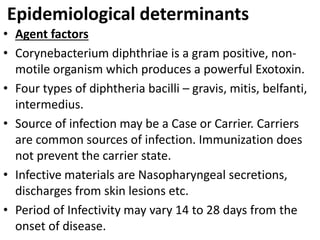This document provides information on diphtheria, including its history, causes, symptoms, treatment and prevention. It notes that diphtheria is caused by Corynebacterium diphtheriae and presents as a membrane in the throat that can lead to breathing difficulties. Major developments in its treatment included the antitoxin developed in the 1890s and vaccines introduced in the early 20th century. Control relies on early detection, isolation, antitoxin treatment and active immunization of infants with diphtheria and combination vaccines.














